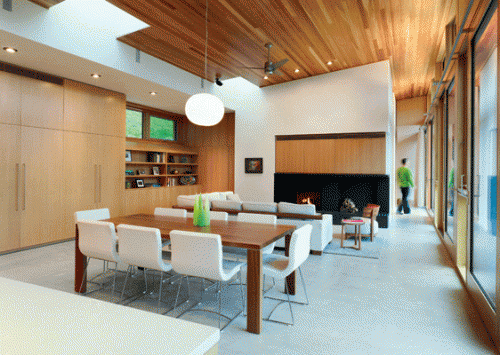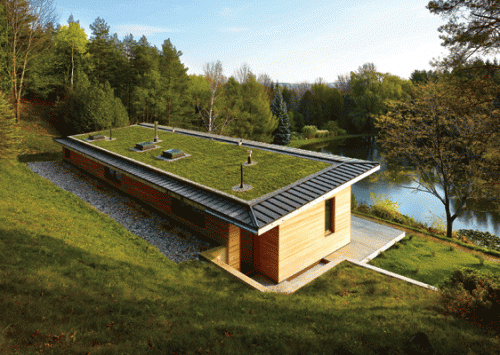Hot off the press
April 19, 2012
My latest article …
The healthy house
Photography by Shai Gil
Four years ago, when Toronto’s Superkül transformed a derelict blacksmith’s shop on a narrow city laneway into a sustainable single-family home, the firm’s preservationist aesthetic went viral with design critics and tree huggers alike. With their latest residential project, in rural Ontario, principals Andre D’Elia and Meg Graham faced a whole other set of limitations: their client lives with acute sensitivities to dust, pollen, electromagnetic radiation and a long list of construction materials, rendering any chance of building in a conventional manner virtually impossible. The result is +House, a two-bedroom dwelling nestled between a hill and a pond that has set a new precedent in Canadian environmental design.
Call it signature Superkül: this cedar- and teak-clad house in Dufferin County, two hours northwest of Toronto, is compact, low lying and well lit, with full-height windows that open up the residence’s entire 82‑metre length. As with many of the firm’s other projects, a green roof perforated with skylights pulls in additional light and air.
But before principal Andre D’Elia fired up CAD, he and project architect Geoffrey Moote spent hours determining what constitutes a healthy house. With the client’s input – “She knows what she can and can’t tolerate” – they quickly eliminated drywall compound (dust), paint (gas emissions), and the idea of a basement (mould). They also made a note to install ductwork with hospital-grade filters. To their surprise, they learned that building materials with higher recycled content aren’t necessarily suitable for everyone. “That’s when the juncture between sustainability and health didn’t always jibe,” says D’Elia.
Attaining a LEED rating wasn’t a major concern initially, not when the team was faced with other issues, including sourcing allergen-free materials, implementing healthy installation methods, and finding contractors willing to work on untried ideas. Not until they began to determine what sort of footprint they could make in the hill, without adversely affecting the trees or the pond, did they consult LEED’s checklist of sustainability points. “The project was always more idiosyncratic than just hitting the LEED basics,” notes Graham. “We spent a lot of time couriering the client boxes of building samples so she could pick them up, smell them, and then wait to see if she had a reaction. The results were very specific to the individual.”
Take the countertops: some types of granite and natural rock emit low levels of radiation, and others contain epoxies that didn’t agree with the client, so they turned instead to IceStone, made from recycled glass. For the walls, they used American Clay, a VOC-free plaster that never dries completely and helps regulate the interior humidity and temperature. Choosing the right millwork proved more challenging. They tested over 40 substrates with the client before settling on a white oak veneer, with AFM Safecoat as the sealant. After the cabinetry was built and sealed, it was put in storage for several months, to allow it time to off-gas. Once they installed the cabinets, they brought in ozone machines to blast away any lingering off-gas.
The risk of leaving behind health-threatening toxins after construction raised another issue of what to do about contaminants being inadvertently introduced. Throughout construction, everyone on the project had to abide by the client’s strict site rules, for instance ensuring that they cleaned their spray guns properly before applying the allergen-free sealant; any residue from other products would have sabotaged the site. Walking on eggshells caused a real issue with some of the subtrades. “We went through three electricians before we found one who was willing to wire the place differently,” says D’Elia. “They all said, ‘Look, I don’t want to be responsible for this.’ ”
In their ongoing effort to keep surfaces dust-free, the designers incorporated passive ventilation, using sliding doors to pull in the southwest breezes coming off the pond, then letting them escape through clerestory windows on the north wall and three skylights. During pollen season, the owners can batten down the hatches and turn on the air conditioning. As for the green roof, rather than providing a specific health solution it visually extended the hill over top of the house, like a blanket, and moderated the interior temperature. It is also a surefire way to attract birds.
team was faced with other issues, including sourcing allergen-free materials, implementing healthy installation methods, and finding contractors willing to work on untried ideas. Not until they began to determine what sort of footprint they could make in the hill, without adversely affecting the trees or the pond, did they consult LEED’s checklist of sustainability points. “The project was always more idiosyncratic than just hitting the LEED basics,” notes Graham. “We spent a lot of time couriering the client boxes of building samples so she could pick them up, smell them, and then wait to see if she had a reaction. The results were very specific to the individual.”
Other health measures taken aren’t as visible. D’Elia and Moote came up with a new electrical wiring solution that almost completely eliminates the fatigue-inducing electromagnetic fields. Instead of using plastic-coated wires, they used wires in steel-coil shields and installed them, not by wrapping them in horizontal runs around each room, but by making vertical runs that came up from the floor or down from the ceiling to that one spot where power was needed.
In the end, no one knew how all of the products would react in combination. “Remember, this was a prototype,” says D’Elia, and as far as they know it’s the first new build to incorporate these elements. “It was a nail-biting experience the first time the client walked in,” recalls Graham. “We were like, ‘Oh God, what’s going to happen?’ ”
Now that the owners are happily living in the home – cooking, reading, doing yoga and watching for wildlife – the architects shouldn’t feel shy about running a victory lap or two. But who remains accountable if the project doesn’t succeed over the long term? While no one signed contracts, it was understood that the designers and contractors would do their best to create the most allergen-free space possible. “It’s always about achieving a synthesis of healthy design, sustainability, and what is classically considered ‘high design,’ ” says Graham. “The intention was never to let one suffer forany of the others.”
You’d be hard-pressed to find another contemporary home that meets that mix of criteria. And with allergies and environmental sensitivities on the rise, it likely won’t be the last.
This was published in the May 2012 issue of Azure Magazine






























Ooooh, I love this house! I want it !
Lovely article, cuz.